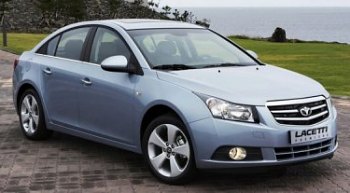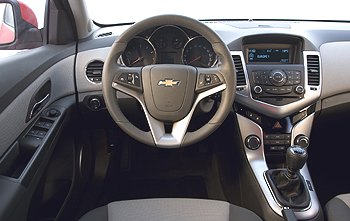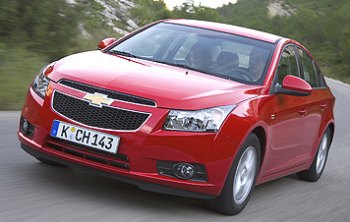|

|
Lacetti is the first fruit of Delta
II, GM's first truly world platform...
|
Never
before a Daewoo is so
important to General Motors. Daewoo Lacetti is not only the first fruit
of GM's new global compact car platform, Delta II, but it will also
appear as Chevrolet Cruze in the global market including North America
and Europe. In China and Australia it will be sold as Buick Cruze and
Holden Cruze respectively. Apart from the main factory in Korea, these
cars will be produced in the United States, China and Russia to supply
the local market. If everything goes according to plan, its production
volume will eventually top 1 million units a year !
And that does not include the 800,000 units or so expected for the next
generation Opel Astra and Zafira, which will be derived from Delta II
platform as well. It goes without saying that Delta II is General
Motor's first truly "world platform", one that consolidates all its
compact cars sold all over the world. This ensure high percentage of
common parts thus greatly reduce purchasing costs.

|
Good looking and solid build surprises
many
|
Daewoo Lacetti and Chevrolet Cruze are
basically the same
car except minor styling differences - actually the front grilles only.
It was designed by an international team of designers located at
Incheon, Korea. Development of the car was also responsible by Daewoo,
at its newly upgraded Bupyung R&D center, though preliminary
engineering of the platform was done in Rüsselsheim by Opel.
Detroit did not involve in its development because, from the painful
lessons learned in Saturn Ion and Chevrolet Cobalt, it understands that
small car is not its strength.
Naturally, for a car designed and built in Korea, we have plenty of
reasons to worry about its styling and build quality. However, once you
see the Lacetti (or Cruze), all such worries will be washed away. This
is a very handsome car, with beautiful proportion and crisped lines.
Body panels are tight fit, the chassis feels solid and the interior
bits are well screwed together. The dashboard design is clean and
stylish. Although soft-touch plastics are absent, all surfaces are
either textured or lined with quality fabrics to give a decent feel. On
the move, there is a grown-up feel as wind and road noise is well
insulated from the cabin.

|
Twin-cockpit design inspired by
Corvette
|
More impressive is the amount of
passenger room. Lacetti /
Cruze runs a wheelbase some 100mm longer than Volkswagen Golf, no
wonder it provides vast of legroom front and rear. Head and shoulder
room are also one of the best in the class. Besides, the sedan layout
provides some 450 liters of trunk space to carry a lot of luggage.
Despite of its new found dimensions and refinement, Lacetti / Cruze
still sells for lower prices than its Japanese and European
counterparts. This is made possible by its lower production cost as
well as its simple mechanical layout. It employs struts and
torsion-beam suspensions front and rear respectively, plus electrical
power steering and conventional 5-speed manual gearbox as standard (a
6-speed auto is optional). Predictably, such layout does not deliver a
sharp and engaging handling, which is evident in its lack of steering
feel and early understeer compared with European cars. However, it is
tuned to deliver comfort and ease of control. It rides supplely over
rough surfaces. It cruises on motorway with plenty calmness. Its
handling is predictable and secured. Most people will be happy with the
way it handles and rides.

|
Chevrolet Cruze is the same as Lacetti
except the front grilles
|
Not so satisfying is performance. This
is because both the
114hp 1.6-liter and 140hp 1.8-liter variable valve timing engines lack
low down torque. Mated with the 5-speed only gearbox, the smaller
engine takes nearly 12 painful seconds to do 0-60 mph. The 1.8-liter
engine claims to do that in less than 10 seconds, but it is still too
slow to cheer about. Moreover, it sounds coarse working at high rev.
What about the optional 6-speed automatic ? it actually makes things
worse by its sluggish response.
The only respectable engine now is the 2.0-liter common-rail direct
injection diesel completed with variable geometry turbocharger, which
also serves Tosca (Epica) and Captiva. This advanced engine, supplied
by Italian diesel engine specialist VM Motori, produces 150 horsepower
and plenty of low down torque, along with reasonable refinement. But
compare with petrol engines it is expensive and heavy, the latter
hampers handling agility a little. Solution will be found next year
when Opel offers its new 1.4-liter turbocharged petrol. Horsepower will
be the same as the current 1.8-liter naturally aspirated engine, but it
will provide a flat torque curve that peak at 148 lb-ft. So keep you
money in bank until then.

|
GM has never produced such a
convincing small cars outside Europe...
|
Undoubtedly, the new Lacetti and Cruze
is a vast improvement
from the previous Nubira / Lacetti. It is handsome, well-built,
accommodating and refined to go. While not exactly exciting to drive,
it is capable enough and should satisfy most family men/women drivers.
General Motors has never produced such a convincing small cars outside
Europe. Is this a sign of revival ? |